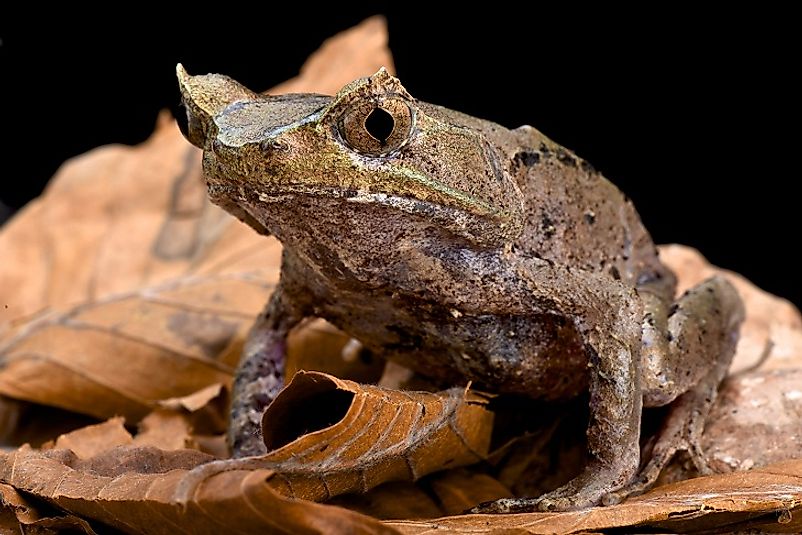Native Amphibians Of Malaysia

Malaysia is a country in Southeast Asia bordering three countries, including Indonesia, Thailand, and Brunei. The country has a tropical climate with monsoons coming from October to February. Malaysia, similar to most of the other Southeast Asian countries, is home to a remarkable amphibian biodiversity. The amphibians of Malaysia represent an outstanding diversity in color, physical characteristics, dietary patterns, and lifestyle. Malaysia’s Island and peninsular territories alike abound with toads, frogs, and legless caecilians.
Native Amphibians Of Malaysia
Chinese Edible Frog (Hoplobatrachus rugulosus)
The Chinese Edible Frog (Hoplobatrachus rugulosus) abounds in Malaysia as well as such other Asian countries as Taiwan, China, Thailand, and Cambodia. The frog has a wide habitat range and inhabits paddy fields, intermittent freshwater marshes, canals, fertile land, pasture land, freshwater marshes, fishponds, urban regions, irrigated infrastructure and ditches. The frog is characterized by its large size of 12 centimeters long or more from snout to vent. Females are differentiated by their larger size than males. The species chiefly feed on insects and breeds in spring and early summer. The frog is listed as Least Concern due to its adaptation to a wide range of habitats, wide distribution, large population, and lack of a notable decrease in its numbers.
Malesian Frog (Limnonectes malesianus)
The Malesian frog (Limnonectes malesianus) is native to the Malay Peninsula in Southeast Asia and distributed across Malaysia, Thailand, Singapore, and Indonesia. The males are slightly larger than the females and their length is between 70 and 150 millimeters, and females range from 75 to 95 millimeters. The skin of the frog is generally smooth with some low bumps on the back and the sides. There are some tiny tubercles above the eyes. The juveniles are mainly creamy brown but the adults are reddish brown. The throat and part of the chest have dark mottling and the underside of the hind limbs is darker. The frog resides in proximity to swampy regions and shallow, gentle streams. The frog has been listed as near threatened, mainly due to habitat loss caused by deforestation and degradation.
Hole-in-the-Head Frog (Huia cavitympanum)
The Hole-in-the-Head Frog (Huia cavitympanum) is endemic to the central and northern regions of the island of Borneo in the Malay Archipelago. The frog mainly inhabits tropical/subtropical montane forests, tropical/ subtropical moist lowland forests, and torrential rivers. The frog can make and hear ultrasonic vocalizations, an ability which enables it to breed in torrential rivers. The frog is listed as Least Concern due to its wide distribution and large numbers. There are at least five protected areas to preserve this unique species of frog. Deforestation and the subsequent silt accumulation in rivers are emerging threats to the species.
Perak Horned Toad (Xenophrys aceras)
The Perak Horned Toad (Xenophrys aceras) is also known as the Malayan horned frog. The toad is characterized by a smooth back with scattered warts, low ridges and short dermal projections above the eyelids. The female grows to a snout-vent length of between 67 and 86 millimeters while that of the male is between 48 and 57 millimeters. The toad has a brown ventral side while the dorsal color varies from brown, grey and bright orange. The species inhabits moist montane forests and tropical moist lowland forests. The tadpoles reside in forest streams. The species has been listed as Least Concern although habitat loss is emerging as a potential threat.
Frilled Tree Frog (Kurixalus appendiculatus)
The Frilled Tree Frog (Kurixalus appendiculatus) is a native amphibian species of Malaysia. The Frog’s snout to vent length is 5.0 centimeters in females and 3.7 centimeters in males. The frog mainly inhabits tropical forests, shrub-lands, swamps and gentle forest streams. The frog is characterized by a brown or mottled green dorsal surface and frills of skin located on the outer surface of its hind limbs. The species is listed as Least Concern as there has been no notable decrease in their numbers. Deforestation in the lowland areas has however been identified as an environmental threat to this species.
Conservation of Malaysian Amphibians
Other native amphibians of Malaysia include Rock Skippers, Dring’s Horned Toads, Seep Frogs, Wallace’s Flying Frogs, and Broad-Striped Caecilians. Although various conservation efforts have been initiated to conserve the native amphibians of Malaysia, more still needs to be done. Deforestation and degradation are major threats which need to be addressed, to ensure sustainability of Malaysia’s native amphibians.
Native Amphibians Of Malaysia
| Native Amphibians of Malaysia | Scientific Name |
|---|---|
| Malesian Frog | Limnonectes malesianus |
| Hole-in-the-Head Frog | Huia cavitympanum |
| Perak Horned Toad | Xenophrys aceras |
| Frilled Tree Frog | Kurixalus appendiculatus |
| Rock Skipper | Staurois latopalmatus |
| Dring's Horned Toad | Xenophrys dringi |
| Seep Frog | Occidozyga baluensis |
| Chinese Edible Frog | Hoplobatrachus rugulosus |
| Wallace's Flying Frog | Rhacophorus nigropalmatus |
| Broad-Striped Caecilian | Caudacaecilia aspleni |







